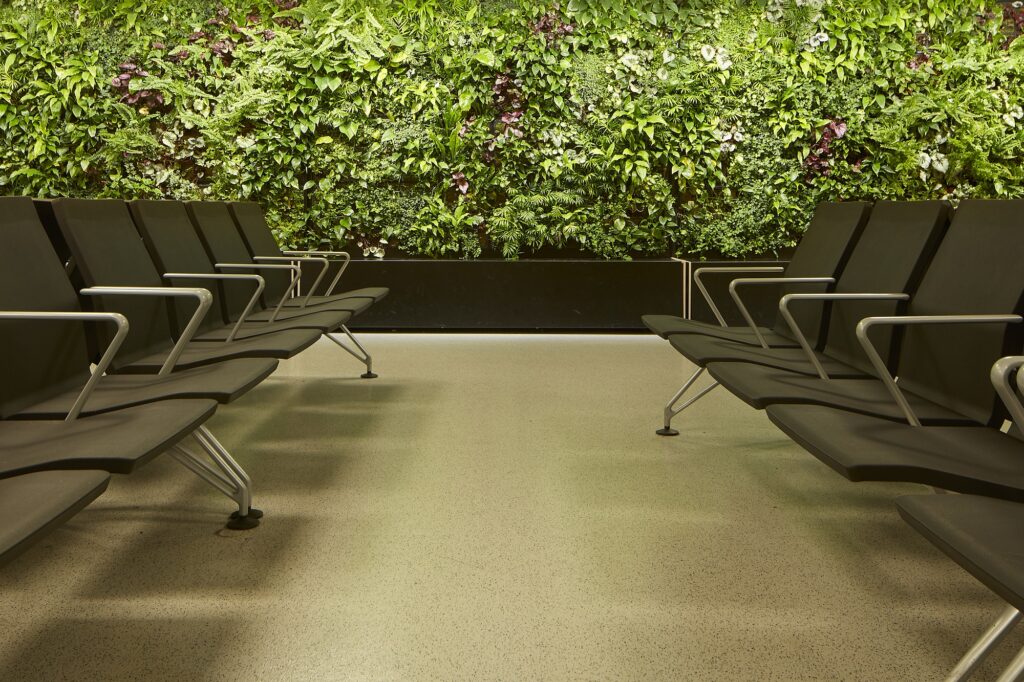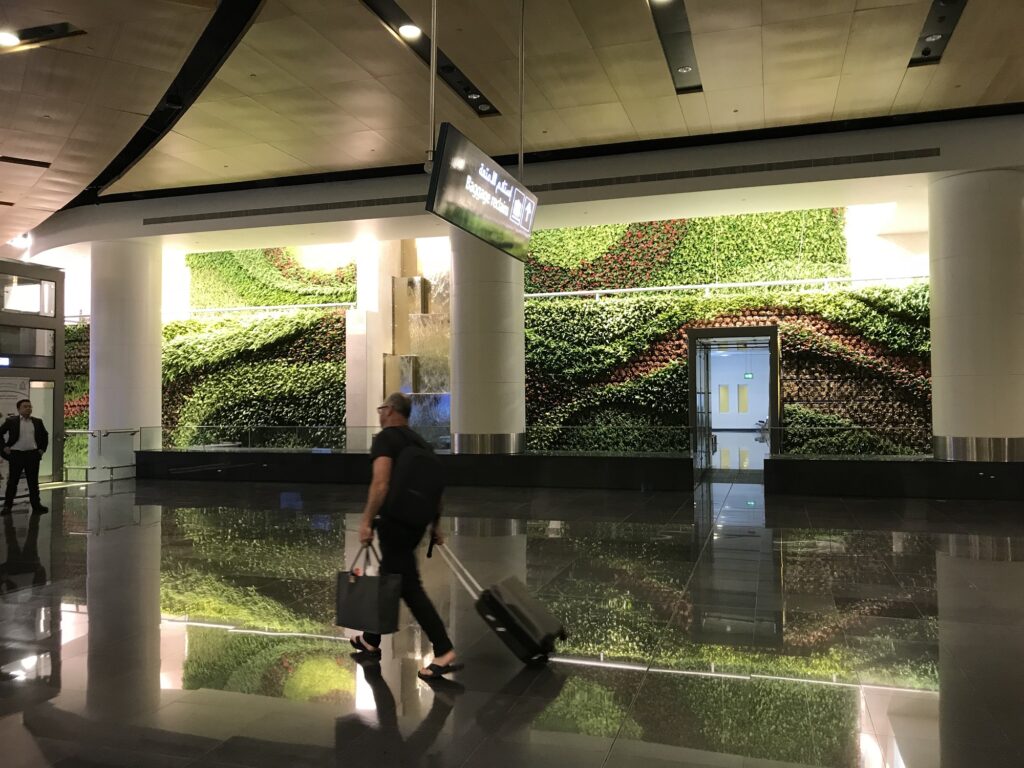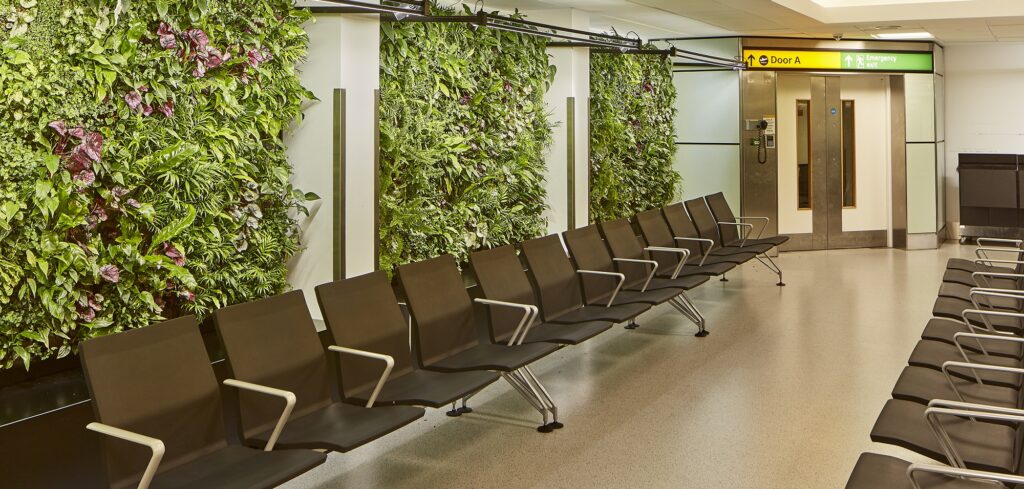Richard Sabin, managing director of living wall manufacturer Biotecture, looks at how incorporating living walls within passenger terminals can help improve well-being, boost relaxation, calm nervous passengers and bring about a whole host of other benefits.
Back in 1995, the anthropologist Marc Auge labelled airports as ‘non-places’, which are devoid of identity, look the same the world over and which exist with the sole purpose of moving people efficiently from one place to another.
Fast forward almost 30 years and airport passenger terminals now feature world-class shopping, fine dining, cinemas, skating rinks and even wedding chapels. Rather than non-places, airports such as Changi in Singapore have now become tourist destinations in themselves.
Modern airport design places customer experience front and center, and cultivating a feeling of calmness and well-being is central to achieving this.
Airports have long used color, design elements, natural light and visual cues to help create a calm, relaxed environment. However, airports such as London Heathrow and Muscat International are now going one step further by incorporating lush green spaces such as living walls to their interior and exterior spaces – to great effect.
As a society, we typically spend around 80-90% of our time indoors, in ‘unnatural’ environments. There is now overwhelming evidence of the value of adding plants and living walls to our indoor spaces, from offices and hospitals to shopping malls and airports.
Cleaner air
Measurable indoor air quality (IAQ) is a key indicator of the health and well-being of our indoor spaces. There is considerable scientific evidence regarding the ability of plants to remove significant quantities of volatile organic compounds (VOCs) from the air. In fact, plants can reduce CO2 levels in indoor spaces by as much as 25%.
Indoor living walls offer the opportunity to put large quantities of toxin-cleaning plants into terminals without taking up valuable floor space. Because they produce their own fresh air, well-designed living walls can also save on energy consumption and ventilation costs by reducing the number of required air changes per hour.
Passenger well-being
The addition of living walls can boost passenger well-being in several ways. Cleaner air means fewer headaches and being surrounded by plants has been proven to be good for our mental health.
Introducing greenery into the terminal makes passengers’ surroundings more aesthetically pleasing and relaxing, encouraging more people to travel through the airport, calming nervous passengers and enhancing customer satisfaction.
Living walls can also reduce noise within the terminal by absorbing, diffracting and reflecting sound. This works best in ‘acoustically live’ spaces, such as airport terminals which typically feature hard surfaces like marble walls and stone floors. Improving acoustics and reducing noise within the terminal will in turn reduce stress levels for travelers.

Boost airport staff satisfaction
Studies have shown that when people can see plants while they carry out their work, productivity, concentration and creativity all increase.
Echo Research reported that employees said they’d feel 62% more motivated if their employers made more of an effort to improve their surroundings, and that they would be 30% more productive as a result. Factors such as natural light, good ventilation and greenery were found to be the most important factors for workplace satisfaction.
In 2014, the British Council for Offices found that 45% of workers said that they would change their job for another one if the working environment was better; even if their role, salary and benefits were to stay the same.
Garden Gate at Heathrow
In 2016, a customer satisfaction survey highlighted Gate 25 in Terminal 3 at Heathrow Airport as one of the lowest scoring at the airport for ‘look and feel’. In an effort to make every journey better, Heathrow had the idea of creating the ‘Garden Gate’ – the concept being an English garden within the airport. By designing bespoke, freestanding, self-contained living wall units, we were able to bring that vision to life, creating an eco-sanctuary within Britain’s busiest airport.
The Heathrow Airport (top and above) living wall consisted of seven panels, measuring 1.8m high x 2.4m wide, each containing 240 plants. Each plant panel was fitted with a water reservoir and nutrient system, which allowed the wall to flourish in an artificial environment. Advancements in LED technology support indoor plant growth using less energy (e.g. more light and less heat).
The plant selection was largely based on research conducted by Dr Bill Wolverton on behalf of NASA, to prove that plants, namely the English Ivy and the Peace Lily, absorbed the air around them and translocated it to their roots, where organisms turned some air particles into food for the plant.
Plant choice is a crucial element of planning living walls, and we work with our clients to determine their goals before recommending a planting scheme. For example, plants with waxy leaves are more effective at removing air pollution.
Before the living wall installation, only 47% of passengers surveyed felt positive or very positive about the ‘look and feel’ of Gate 25. But after the living wall was installed that rose dramatically to 72%, demonstrating just how big an impact living walls can have on the customer experience.
 Largest living walls in the GCC
Largest living walls in the GCC
In order to keep pace with rapid growth of business and tourism travel, the gulf state of Oman has invested in the expansion of its international airport in Muscat, with the ultra-modern new passenger terminal spanning a total of 335,000m2 .
Uniflora, our partner company in the GCC, worked with the architects and the client to design and install a pair of stunning, identical living walls within the arrival and departure areas. Stretching across three levels, these are the largest living walls of their kind in the GCC, featuring 13 different plant species and a total of 24,000 individual plants.
The living walls at Muscat International (above) create a wonderful first impression, breathing life into the public realm and creating a pleasant, calm and relaxing environment for travelers.
Importantly, they also help to improve air quality and provide all the health and well-being benefits that people get from being close to nature.
Muscat International is a great example of how living walls can make a huge statement about an airport’s commitment to clean air and sustainability, while making an even bigger difference to the well-being of the people who use the terminal.

